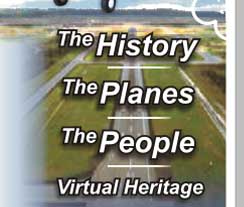 Heritage Community Foundation Presents
Heritage Community Foundation PresentsAlberta Online Encyclopedia
|
|
|
|
|||
 |
|||||
|
|
Home | About Us | Contact Us | Partners | Sitemap |
|
|||
|
|


|
||||
|
Home>>
The History>>
Between the Wars>>
Blatchford Field, Edmonton |
|||||
|
Blatchford Field, Edmonton (1926) |
|||||
 As aircraft continued to play an important role in
transportation into the north, and in roles such as fire
patrols, surveying, geology, and the extraction of natural
resources, Edmonton became the gateway. Central to these
developments was the base of activity for the pilots, which
became known as Blatchford Field. The field at the Hangmann farm
became a central location for pilots like Wop May and George
Gorman to fly out of in the 1920s. It was named after the
mayor of Edmonton, Kenneth A. Blatchford, and in 1926, $400 was
received from the federal government to keep the soil packed
down and the runways free of
weeds. With this donation came the field's official
designation as the first "Air Harbour" in Canada. As aircraft continued to play an important role in
transportation into the north, and in roles such as fire
patrols, surveying, geology, and the extraction of natural
resources, Edmonton became the gateway. Central to these
developments was the base of activity for the pilots, which
became known as Blatchford Field. The field at the Hangmann farm
became a central location for pilots like Wop May and George
Gorman to fly out of in the 1920s. It was named after the
mayor of Edmonton, Kenneth A. Blatchford, and in 1926, $400 was
received from the federal government to keep the soil packed
down and the runways free of
weeds. With this donation came the field's official
designation as the first "Air Harbour" in Canada.
Captain James Bell became the first manager of the Edmonton Municipal Airport in 1930 when the City of Edmonton took over operation of the airport from the Northern Alberta Aero Club. As the vice-president of the flying club, an RAF veteran, and a former city employee, Bell was well-suited to the position. He quickly gained a reputation for excellent service and organization, and was manager until 1962.
The airfield played an important role in assisting the massive effort to build the Alaska Highway in 1942. Blatchford Field was also used by the United States to carry out airlifts to Alaska. By 1943, Blatchford Field had the record for all of North America as the busiest airfield. Blatchford Field was first renamed as the Industrial Airport, later became known as the Municipal Airport, and finally as the Edmonton City Centre Airport. The airport, close to downtown Edmonton, continues to play an important role in Alberta aviation today, serving mostly private aircraft with a capacity of 19 seats or less. Source: Myers, Patricia A. Sky Riders: An Illustrated History of Aviation in Alberta 1906-1945. Saskatoon: Fifth House, 1995. |
|||||
|
|
|||||
|
|
Copyright © 2004 Heritage Community Foundation All Rights Reserved |
|
|||
 |
|||||
††††††††††† For more on aviation in Alberta, visit Peelís Prairie Provinces.



